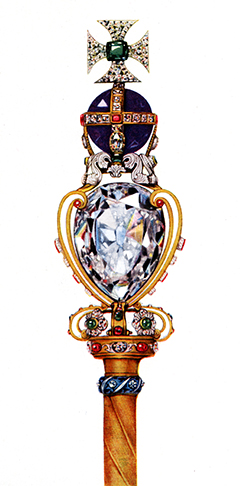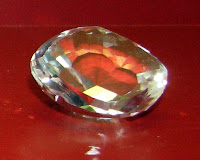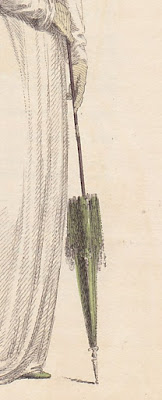All
prints are from Ackermann’s Repository...and
for once I have the original descriptions for most of them. Enjoy!
January’s cozy-looking Walking Dress is described as “A round high morning robe of cambric, with deep
full-trimmed collar. A Swedish coat of lead-coloured cloth, or black velvet,
trimmed entirely round with swansdown or blue fox fur. A Spanish pelerine
[a short cape] of the same, fastened in front of the throat with a
mother-of-pearl broach; clasps to correspond for the bottom of the waist. A
traveller’s hat of black or grey velvet, or cloth, turned up on the left side
with a shell ornament. Half-boots of grey cloth, laced and bound with black
velvet. Chinese ridicule of grey or lead-coloured satin, embellished with black
medallions and tassels. Gold chain and eye-glass.”
Someone
had fun with the description of these Evening
or Opera Dresses in February’s Ackermann’s Repository—truly global
ensembles! “First figure.—A round robe of white crape or muslin, with demi-traine
and imperial winged frill of plaited lace. A Circassian laced bodice of
American green velvet, trimmed at the bottom of the waist with a
mother-of-pearl clasp. An Armenian head-dress composed of white satin, with
silver antique ornament in front. Necklace consisted of a single row of large
pearls, with a cross of the same, suspended in the center of the bosom; the
cuffs of the long sleeve ornamented with pearl. An Eastern mantle of
amber-coloured velvet, trimmed with swansdown. Shoes of velvet, the same as the
bodice. Glove, white kid.
Second Figure.
–A Grecian frock of celestial blue, or silver grey net, with full long sleeve,
and biassed bosom; ornamented round the bottom and bosom with a vandyke border,
composed of white velvet and beads; deep antique cuffs of the same. The robe
worn over an under-dress of white satin. Head-dress composed of a French net
veil, confined and ornamented in front of the forehead with a tiara of silver.
Necklace and cross of white cornelian, and gold ear-rings to correspond. A
carmelite cloak, of light purple or violet velvet, lined and bordered with
white ermine. Blue kid slippers, with silver clasps; and gloves of white kid.”
I was delighted that this print of a Walking Dress from April was accompanied by its description,
because I was unsure what the trim was made of—silk fringe? Fur? Nope! It’s feathers! How awesome is that? “A Cossack coat, or short pelisse, or violet
coloured sarsnet, lined with white Persian, and trimmed entirely round with an
Indian border of feathers. A woodland hat, composed of the same materials, with
a small Angola feather in front. Under-dress.—A high round robe of jaconot
muslin, ornamented at the feet, and on the bosom, with needlework or lace; a
full frill of the latter around the throat. Half-boots of violet kid; and
gloves a pale tan colour.”
A lot of these earlier Ackermann prints feature
children’s outfits, which is interesting to see...as in this Opera Dress from May (though I rather
doubt the child was invited to go along with Mum!) “A white muslin robe, with long sleeves. An
Algerian tunic of white satin, trimmed round the bottom and bosom with net or
silver fringe, simply confined in the center with a regency broach. A Turkish
cloak, or short coat, with arm-holes, composed of plain Indian muslin similar
with the robe, and lined with cerulean blue sarsnet; trimmed round the back and
down each side with broad lace, put on very full. The cloak thrown open in
front, so as to exhibit the tunic and under-robe. A helmet cap, composed of
silver net and spangles, ornamented with a cluster of the Labrador roses in
front. A treble neck-chain and ear-rings of elastic Indian gold. Gloves and
shoes of white kid. CHILD’S DRESS. A
short frock and trowsers of plain Indian muslin, trimmed with thread lace, or
flounces of the same. A short French tunic coat of white sarsnet or cambric,
with full-arched collar, tied at the throat with a silk cord and tassels, and
the bottom trimmed with lace, siilar to that which ornaments the frock and
trowsers. White kid gloves and slippers. Hair a tufted crop.”
Promenade Dresses from June...I rather like the pelisse at left in violet! “A round robe of plain jaconot muslin, with a border of needle-work at the feet. A Roman coat of violet shot sarsnet, with pointed cape; binding and tassels of jonquil silk. A Parisian cap of sarsnet, same as the pelisse, ornamented with a broad braid of jonquil silk, and a fancy flower placed toward the left side. A veil of fine white lace, thrown negligently over the head-dress, shading the throat, and falling on the shoulders. Half boots of violet silk or French kid. Gloves of jonquil kid. A round high walking dress of fine oblique corded muslin, with high arched collar, trimmed with a narrow full edging of muslin or plain net lace, and finished at the feet with narrow tucks. A Roman helmet of sea-green sarsnet, terminated with a Tuscan band of cut white velvet. A short winged veil, or under cap of transparent net, caught up in the center of the forehead. A Grecian drapery scarf of sea green sarsnet; parasol to correspond. Shoes of similar coloured kid. Blossom coloured ridicule, and primrose or pale tan gloves.”
In this Opera
Dress from July is another child’s costume. Perhaps, since it is July and
most fashionable society has left London, it was not frowned upon to bring
children to theatrical performances? The
description reads, “A round robe of imperial violet net-crape, or leno, with a
long sleeve of the same, worn over a white satin under-dress. A cottage vest,
or boddice, of Chinese crape, tabinet, or satin, laced and tagged with
correspondent cord and tassels. Under-dress shading closely the bosom ad
shoulders. A large unella veil, confined in front with a gold tiara, and a
simple rose on one side, flowing in negligent folds over the rest of the
figure. Neck-chain and bracelets of finely carved amber, or oriental elastic
gold. French repeating watch, with elastic gold chain and seals. Bouquet on the left side of the bosom. White
satin slippers; and gloves of white kid.
YOUTH'S DRESS. A jacket and
trowsers, à la militaire, of Windsor grey
cloth. White Marseilles dimity waistcoat, ornamented to correspond; collar and
frill in the antique style; hair a waved crop. The pomposo, or Moorish half-boot, of yellow or black Morocco. This latter
dress was furnished by Mr. S. Clark, tailor and ladies’ habit-maker, No. 37,
Golden-square."
But now that August has arrived, it’s time to hit the beach in this Walking Dress: I love her turban-style hat and bobble-fringed short cloak with matching parasol, which seems to be mightily entertaining the young man with her (and what a practical boys’ outfit that it!)
I rather like the hat for this Promenade Costume (September): “A round high robe, with large long sleeves, and deep falling collar, edged with lace or needle-work, composed of jaconot muslin. A small capuchin mantle of green shot sarsnet, lined with white, and trimmed with Chinese silk fringe or corresponding shades; deep Spanish pointed cape, trimmed with the same. White satin hat, of the Spanish form, with rim the colour of the mantle, ornamented with a demi-wreath of corn-flowers. Roan shoe of green morocco. Gloves of lemon-coloured kid; and parasol corresponding with the cloak, with deep Chinese awning."
Also from September is a Morning Dress, “A Chinese robe with full long sleeve, composed of fine imperial, or plain cambric muslin; trimmed round the throat and wrist, and down the front, with a full plaited border of plain muslin. A French foundling cap, formed of alternate stripes of lace and white satin, ornamented with blossom-coloured ribbon, and autumnal flowers to correspond. A pelerine of spotted muslin or net, trimmed entirely round with lace or muslin, and thrown loosely over the shoulders. Shoes and gloves of lemon-coloured kid. These dresses are furnished by Mrs. Gill, No.1, Cork-street, Burlington-gardens; whose extensive and elegant assortment of millinery, robes, &c. &c. has rendered her so justly eminent in her line.
Well, I think that catches us up for 1811. Do any of these dresses catch your fancy?
And in other news...my SKIN DEEP was just announced as a finalist in the 2017 New England Readers' Choice Contest in the paranormal category--hurrah! It's also still on sale for 99¢ (ebook only) for one more week at Amazon, Barnes and Noble, Apple iBooks, and Kobo, so now's your chance...
And in other news...my SKIN DEEP was just announced as a finalist in the 2017 New England Readers' Choice Contest in the paranormal category--hurrah! It's also still on sale for 99¢ (ebook only) for one more week at Amazon, Barnes and Noble, Apple iBooks, and Kobo, so now's your chance...







































